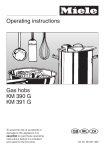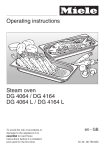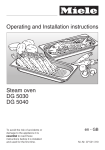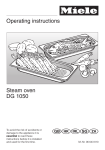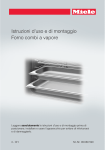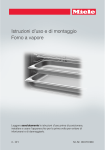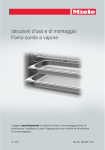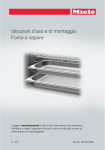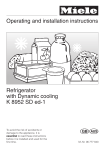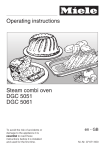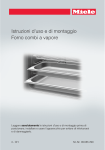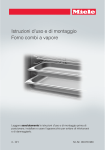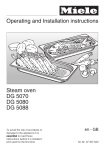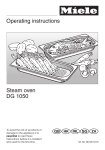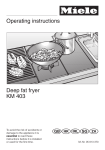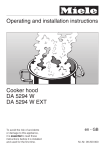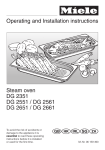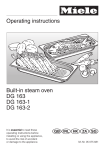Download Miele DG 4064 L Oven User Manual
Transcript
Operating instructions Steam oven DG 4064 DG 4064 L To avoid the risk of accidents or damage to the appliance it is essential to read these instructions before it is installed and used for the first time. GiZ M.-Nr. 06 786 680 Contents Description of the appliance . . . . . . . . . . . . . . . . . . . . . . . . . . . . . . . . . . . . . . . . . 4 Front view. . . . . . . . . . . . . . . . . . . . . . . . . . . . . . . . . . . . . . . . . . . . . . . . . . . . . . . . . 4 Controls and displays . . . . . . . . . . . . . . . . . . . . . . . . . . . . . . . . . . . . . . . . . . . . . . . 5 Accessories supplied . . . . . . . . . . . . . . . . . . . . . . . . . . . . . . . . . . . . . . . . . . . . . . . 6 Optional accessories . . . . . . . . . . . . . . . . . . . . . . . . . . . . . . . . . . . . . . . . . . . . . . . . 7 Warning and Safety instructions . . . . . . . . . . . . . . . . . . . . . . . . . . . . . . . . . . . . . 9 Caring for the environment . . . . . . . . . . . . . . . . . . . . . . . . . . . . . . . . . . . . . . . . . 15 Before using for the first time . . . . . . . . . . . . . . . . . . . . . . . . . . . . . . . . . . . . . . . 16 Setting the water hardness level . . . . . . . . . . . . . . . . . . . . . . . . . . . . . . . . . . . . . . 16 Location . . . . . . . . . . . . . . . . . . . . . . . . . . . . . . . . . . . . . . . . . . . . . . . . . . . . . . . . . 16 Opening and closing the door . . . . . . . . . . . . . . . . . . . . . . . . . . . . . . . . . . . . . . . . 17 Cleaning and heating up for the first time . . . . . . . . . . . . . . . . . . . . . . . . . . . . . . . 18 Operation . . . . . . . . . . . . . . . . . . . . . . . . . . . . . . . . . . . . . . . . . . . . . . . . . . . . . . . 19 Before each use. . . . . . . . . . . . . . . . . . . . . . . . . . . . . . . . . . . . . . . . . . . . . . . . . . . 19 Programming steps in brief . . . . . . . . . . . . . . . . . . . . . . . . . . . . . . . . . . . . . . . . . . 19 Programme chart . . . . . . . . . . . . . . . . . . . . . . . . . . . . . . . . . . . . . . . . . . . . . . . . . . 20 Switching on and selecting a programme . . . . . . . . . . . . . . . . . . . . . . . . . . . . . . . 21 Altering the recommended temperature . . . . . . . . . . . . . . . . . . . . . . . . . . . . . . . . 21 Setting a cooking duration . . . . . . . . . . . . . . . . . . . . . . . . . . . . . . . . . . . . . . . . . . . 22 Starting a programme . . . . . . . . . . . . . . . . . . . . . . . . . . . . . . . . . . . . . . . . . . . . . . 22 Interrupting a programme . . . . . . . . . . . . . . . . . . . . . . . . . . . . . . . . . . . . . . . . . . . 23 Changing a programme. . . . . . . . . . . . . . . . . . . . . . . . . . . . . . . . . . . . . . . . . . . . . 24 At the end of the cooking duration . . . . . . . . . . . . . . . . . . . . . . . . . . . . . . . . . . . . 25 After use. . . . . . . . . . . . . . . . . . . . . . . . . . . . . . . . . . . . . . . . . . . . . . . . . . . . . . . . . 26 Practical tips. . . . . . . . . . . . . . . . . . . . . . . . . . . . . . . . . . . . . . . . . . . . . . . . . . . . . 27 Suitable containers . . . . . . . . . . . . . . . . . . . . . . . . . . . . . . . . . . . . . . . . . . . . . . . . 27 Steaming . . . . . . . . . . . . . . . . . . . . . . . . . . . . . . . . . . . . . . . . . . . . . . . . . . . . . . . . 28 Reheating. . . . . . . . . . . . . . . . . . . . . . . . . . . . . . . . . . . . . . . . . . . . . . . . . . . . . . . . 32 Defrosting. . . . . . . . . . . . . . . . . . . . . . . . . . . . . . . . . . . . . . . . . . . . . . . . . . . . . . . . 33 Cooking whole meals. . . . . . . . . . . . . . . . . . . . . . . . . . . . . . . . . . . . . . . . . . . . . . . 35 Blanching . . . . . . . . . . . . . . . . . . . . . . . . . . . . . . . . . . . . . . . . . . . . . . . . . . . . . . . . 35 Bottling . . . . . . . . . . . . . . . . . . . . . . . . . . . . . . . . . . . . . . . . . . . . . . . . . . . . . . . . . . 36 Extracting juice with steam . . . . . . . . . . . . . . . . . . . . . . . . . . . . . . . . . . . . . . . . . . 37 2 Contents Safety features . . . . . . . . . . . . . . . . . . . . . . . . . . . . . . . . . . . . . . . . . . . . . . . . . . . 38 Pressure release / Safety valve . . . . . . . . . . . . . . . . . . . . . . . . . . . . . . . . . . . . . . . 38 Overheating protection . . . . . . . . . . . . . . . . . . . . . . . . . . . . . . . . . . . . . . . . . . . . . 40 Safety lock . . . . . . . . . . . . . . . . . . . . . . . . . . . . . . . . . . . . . . . . . . . . . . . . . . . . . . . 41 Cleaning and care . . . . . . . . . . . . . . . . . . . . . . . . . . . . . . . . . . . . . . . . . . . . . . . . 42 General notes . . . . . . . . . . . . . . . . . . . . . . . . . . . . . . . . . . . . . . . . . . . . . . . . . . . . 42 E-cloth . . . . . . . . . . . . . . . . . . . . . . . . . . . . . . . . . . . . . . . . . . . . . . . . . . . . . . . . . . 42 Appliance front. . . . . . . . . . . . . . . . . . . . . . . . . . . . . . . . . . . . . . . . . . . . . . . . . . . . 42 Cooking containers and drain filter . . . . . . . . . . . . . . . . . . . . . . . . . . . . . . . . . . . . 43 Door seal . . . . . . . . . . . . . . . . . . . . . . . . . . . . . . . . . . . . . . . . . . . . . . . . . . . . . . . . 43 Safety valve . . . . . . . . . . . . . . . . . . . . . . . . . . . . . . . . . . . . . . . . . . . . . . . . . . . . . . 43 Cooking compartment and pull-out shelf . . . . . . . . . . . . . . . . . . . . . . . . . . . . . . . 44 Shelf runners . . . . . . . . . . . . . . . . . . . . . . . . . . . . . . . . . . . . . . . . . . . . . . . . . . . . . 45 Water nozzle . . . . . . . . . . . . . . . . . . . . . . . . . . . . . . . . . . . . . . . . . . . . . . . . . . . . . 46 Descaling . . . . . . . . . . . . . . . . . . . . . . . . . . . . . . . . . . . . . . . . . . . . . . . . . . . . . . . . 47 Programming . . . . . . . . . . . . . . . . . . . . . . . . . . . . . . . . . . . . . . . . . . . . . . . . . . . . 50 Problem solving guide. . . . . . . . . . . . . . . . . . . . . . . . . . . . . . . . . . . . . . . . . . . . . 52 Services . . . . . . . . . . . . . . . . . . . . . . . . . . . . . . . . . . . . . . . . . . . . . . . . . . . . . . . . 55 Technical data . . . . . . . . . . . . . . . . . . . . . . . . . . . . . . . . . . . . . . . . . . . . . . . . . . . . 55 Plumbing . . . . . . . . . . . . . . . . . . . . . . . . . . . . . . . . . . . . . . . . . . . . . . . . . . . . . . . . 55 Electrical connection . . . . . . . . . . . . . . . . . . . . . . . . . . . . . . . . . . . . . . . . . . . . . . . 55 After sales service, data plate. . . . . . . . . . . . . . . . . . . . . . . . . . . . . . . . . . . . . . . 57 3 Description of the appliance Front view a Controls and displays b On/Off button c Overheating protection device cover cap d Door handle e Door release f Pull-out shelf g Appliance door h Door button i Opening for adding descaling agent j Lift-up door (only on appliances with an "L" in the model number) k Temperature sensor l Steam vent m Deflector plate for water nozzle n Shelf runners o Door contact switch p Drain filter 4 Description of the appliance Controls and displays q Programme/temperature display with symbols for the following programmes: °Steam with pressure P Steam without pressure Ä Reheat N Defrost a Safety lock k Descale P Programming r Temperature button s Programme button t Temperature button + u Time display with symbol for: g Duration of programme v Time button - w Start/Stop button - x Time button + 5 Description of the appliance Accessories supplied Additional accessories can be ordered at extra cost. See "Optional accessories" for more information. 2 cooking containers DGGL 1, perforated (gross capacity 1.5 litres/ usable capacity 0.9 litres) 1 tray For placing dishes on For steaming Gastronorm size GN 1/3 325x175x40 mm (WxDxH) Descaling agent For descaling the appliance 1 cooking container DGG 2, solid (gross capacity 2.5 litres/ usable capacity 2.0 litres) For cooking food in sauces and stock, as well as for pasta and rice Gastronorm size GN 1/3 325x175x65 mm (WxDxH) Silicone washers For pressure release Dispensing syringe for descaling agent Cook book 6 Description of the appliance Optional accessories Stainless steel containers Item Use Gross/usable Height in mm capacity in litres Width x Depth in mm For cooking vegetables, fish, DGGL 5 perforated meat and potatoes (GN 1/3)* 2.5 / 2.0 65 325 x 175 As DGGL 5, DGGL 6 perforated but deeper (GN 1/3) 4.0 / 2.8 100 325 x 175 4.0 / 2.8 100 325 x 175 5.7 / 4.2 150 325 x 175 5.7 / 4.2 150 325 x 175 - - - DGG 7 solid (GN 1/3) For cooking a medium sized quantity of soup or a medium sized casserole DGG 9 solid (GN 1/3) As DGG 7, but deeper DGGL 10 As DGGL 5, perforated but deeper (GN 1/3) DGD Lid for solid cooking containers DGG 2 and DGG 7 * Gastronorm size 1/3 indicates the width and depth of the container. 7 Description of the appliance Other accessories Item Use Neoblank stainless steel conditioning agent 250 ml Helps prevent re-soiling. Miele E-Cloth For easy, effective cleaning without the use of chemicals. (machine washable). Miele accessories are available from - your Miele dealer or - the Miele Spare Parts Department (see back cover for contact details). 8 Warning and Safety instructions This appliance complies with all relevant legal safety requirements. Improper use of the appliance can, however, present a risk of both personal injury and material damage. To avoid risk of accidents and damage to the appliance, please read these instructions carefully before installation and before using it for the first time. They contain important notes on the safety, operation and care of the appliance. The use of the appliance by the elderly or infirm, or those who have not used the appliance before, should be supervised by a competent and responsible person to avoid the risk of injury. Stick the extra data plate supplied with the appliance in the space provided later in these instructions under "After sales service, data plate". Keep these instructions in a safe place, and pass them on to any future user. The electrical safety of this appliance can only be guaranteed when continuity is complete between it and an effective earthing system which complies with current local and national safety regulations. It is most important that this basic safety requirement is present and tested regularly, and where there is any doubt, the household wiring system should be inspected by a qualified electrician. The manufacturer cannot be held liable for the consequences of an inadequate earthing system (e.g. electric shock). Do not connect the appliance to the mains electricity supply by an extension lead. Extension leads do not guarantee the required safety of the appliance (e.g. danger of overheating). This appliance may only be used in mobile installations such as ships, caravans, aircraft etc. if a risk assessment of the installation has been carried out by a suitably qualified engineer. The top edge of the appliance door should not be above eye level. If it is too high, you will find it difficult to access all levels safely when putting dishes into the oven and taking them out, and there is a danger of food spillages and possible scalding. Installation and connection The appliance must be installed and connected by a suitably qualified and competent person in strict accordance with current local and national electrical and plumbing safety regulations. The manufacturer cannot be held liable for damage caused by incorrect installation or connection. 9 Warning and Safety instructions Correct usage For safety reasons this appliance must only be operated after it has been built in. This is necessary to ensure that all electrical components are shielded. This appliance is intended for domestic use only and is not to be used for commercial purposes. This appliance must only be used as described in these instructions. Any other usage is at the owner's risk and could be dangerous. The manufacturer cannot be held liable for damage resulting from incorrect or improper use or operation. Make sure that the stopcock is open before using the appliance. After switching off the appliance, remember to close the stopcock to avoid any risk of water damage. Appliances with lift-up door: Leave the lift-up door open whenever the appliance is being used. 10 Do not use the appliance without the filter in the bottom of the cooking compartment in place. Otherwise coarse soiling could get into the drainage system and pump, causing a blockage. Descaling must only be carried out on a cold appliance. Otherwise harmful vapours can form. See "Descaling". Wipe out the appliance with a cloth after each use and leave the door open until the moisture in the cooking compartment has dissipated. If the appliance is not going to be used for a longer period of time, e.g. whilst on holiday, it should be thoroughly cleaned beforehand to prevent the build up of odours etc. Proceed as described under "Cleaning and heating up for the first time". Leave the door open afterwards. Warning and Safety instructions Safety with children The appliance must be installed at such a height that small children cannot reach the appliance door, which gets hot during use. Use the safety lock to prevent children operating the appliance or altering the settings. The appliance is only intended for use by adults who have read these instructions. This appliance is not a toy! To avoid the risk of injury, keep children well away, and do not allow them to play with it or use the controls. They will not understand the potential dangers posed by it. They should be supervised whenever you are working in the kitchen. Warning: Take care in the area around the door hinge. Danger of injury. Keep children well away. Packaging, e.g. cling film, polystyrene and plastic wrappings, must be kept out of the reach of babies and young children. Danger of suffocation. Dispose of or recycle all packaging safely as soon as possible. Before discarding an old appliance, switch off and disconnect it from the power supply. Cut off the cable directly behind the appliance to prevent misuse. This should be done by a competent person. Ensure the appliance prevents no danger to children while being stored for disposal. The appliance gets hot when in use and remains hot for quite a while after being switched off. To safeguard against burning, keep children well away from the appliance at all times. 11 Warning and Safety instructions Protecting the appliance from damage Do not use the appliance to heat up food in sealed jars and tins. Pressure will build up inside them, and they can explode causing damage to the appliance, as well as the risk of injury and scalding. Do not store cooked food in the oven. The moisture in the food can lead to corrosion in the appliance. Do not use metallic containers or utensils in the oven which are likely to rust. This can cause corrosion. Do not use a steam cleaner to clean this appliance. The steam could reach electrical components and cause a short circuit. Pressurised steam could also cause permanent damage to the surface and to other components, for which the manufacturer cannot accept liability. 12 The appliance is designed to detect and then self-correct certain operational faults. If a fault is detected, the fault messages F06 to F95 will appear in the display. The door of the appliance can only be opened when the fault message is flashing in the display. If the fault message is not flashing, the appliance is still processing the fault. See "Problem solving guide" for further information. Warning and Safety instructions Protection from burning and scalding The appliance, especially the door, becomes extremely hot during use, and remains hot for some time after switching off. Be careful only to touch the door button and door handle when the oven door is hot. To protect your hands, use heat-resistant pot holders or oven gloves when using the appliance. Do not let them get damp or wet, as this causes heat to transfer through the material more quickly with the risk of scalding or burning yourself. When putting dishes into the oven or taking them out, take care not to spill the contents. Do not come into contact with hot steam. Danger of scalding. If bottling, do not use temperatures higher than 95 °C (90 °C if the appliance is installed higher than 1000 m above sea level). Higher temperatures can cause the jars to shatter. Danger of injury. Pull out the shelf underneath the appliance before opening the door. You can place hot containers on the shelf and it will also collect any drops of hot water. On no account attempt to force the door open during a programme. The door may only be opened when: - the cooling down phase is finished, - the beep has stopped, - the g symbol is flashing in the time display. Otherwise there is a danger of burning or scalding. Attempts to open the door before a programme has run its course will cause an alarm to sound, and the word door to appear in the time display. 13 Warning and Safety instructions Appliance faults Futher safety notes In the event of damage or a defect, switch off the appliance immediately. Close the stopcock and disconnect from the mains electricity supply. Contact the Service Department. Ensure that current is not supplied to the appliance until after maintenance or repair work has been carried out. When using an electric socket near the appliance, care should be taken that the cable of the appliance cannot get trapped by the appliance door. The insulation on the cable could become damaged, giving rise to an electric shock hazard. Repairs may only be carried out by a service technician authorised by the manufacturer. Repairs and other work by unqualified persons could be very dangerous and invalidate the guarantee. Never open the housing of the appliance. In countries where there are areas which may be subject to infestation by cockroaches or other vermin, pay particular attention to keeping the appliance and its surroundings in a clean condition at all times. Any damage which may be caused by cockroaches or other vermin will not be covered by the guarantee. 14 Always ensure that food is sufficiently cooked or reheated. Many factors will affect the overall cooking time, including the size and amount of food and its temperature. Some foods, e.g. poultry, may contain micro-organisms which are only destroyed by thorough cooking at a sufficiently high temperature for long enough. If in doubt, select a longer cooking or reheating time. Warning: Take care in the area around the door hinge. Danger of injury. Do not use plastic containers. These melt at high temperatures. The manufacturer cannot be held liable for damage caused by non-compliance with these Warning and Safety instructions. Caring for the environment Disposal of the packing material The transport and protective packing has been selected from materials which are environmentally friendly for disposal and can normally be recycled. Packaging, e.g. cling film, polystyrene and plastic wrappings, must be kept out of the reach of babies and young children. Danger of suffocation. Disposal of your old appliance Electrical and electronic appliances often contain materials which, if handled or disposed of incorrectly, could be potentially hazardous to human health and to the environment. They are, however, essential for the correct functioning of your appliance. Please do not therefore dispose of your old appliance with your household waste. Dispose of or recycle all packaging materials safely as soon as possible. Please dispose of it at your local community waste collection / recycling centre and ensure that it presents no danger to children while being stored for disposal. It should be unplugged or disconnected from the mains electricity supply by a competent person. If connected by a plug, the plug must be rendered useless and the cable cut off directly behind the appliance to prevent misuse. 15 Before using for the first time Setting the water hardness level The steam oven is set at the factory to water hardness range IV (04) . If your water hardness level differs from this you will need to re-programme the appliance. Proceed as described in "Programming". You can use the test strip supplied to check the water hardness level, or your local water supplier will be able to advise you on the water hardness of your area. The water hardness is shown as settings I to IV equivalent to the German scale 1 to >21 °dH (0.2 > 3.8 mmol/l). Hardness level Display Hardness range I 01 1-7 °dH (0.2 - 1.3 mmol/l) II 02 8-14 °dH (1.4 - 2.5 mmol/l) III 03 15-21 °dH (2.7 3.8 mmol/l) IV 04 >21 °dH (above 3.8 mmol/l) 16 Location If the steam oven is installed at an altitude higher than 1,000 m above sea level, the boiling point for water will be lower than the boiling point for water at sea level. To cater for this, the boiling point for water in the appliance can be altered. Proceed as described in "Programming". Before using for the first time Opening and closing the door To close the door: Pull out the shelf underneath the appliance before opening the door. You can place hot containers on the shelf and it will also collect any drops of hot water. ^ Turn the handle to the horizontal position. This ensures that the door lugs are lined up with those on the cooking compartment opening (see arrows). To open the door: ^ Using the thumb of your right hand, push the door release forwards and turn the handle upwards until the handle is in a horizontal position. ^ Using your left hand, press firmly on the door button. The oven door is now unlocked and can be opened. ^ Using your right hand, turn the handle downwards until you hear it engage. While doing so, also push the door release forwards with your thumb. This vents the cooking compartment and makes it easier to close the door. Do not attempt to force the door open during a programme. Danger of burning and scalding. If you attempt to open the door during a programme or before the cooling down phase has finished, an alarm will sound and the word door will appear in the time display. The steam oven cannot be used until the door has been closed properly. ^ Push the shelf back in again. 17 Before using for the first time Cleaning and heating up for the first time The appliance and accessories have been treated with a conditioning agent before leaving the factory. Use a solution of hot water with a little washing-up liquid to remove it. 18 You should then run the 120 °C Steam with pressure ° programme for 10 minutes to flush out the waterways. Proceed as described in "Operation". Operation Before each use Check that - the stopcock is open. - the filter at the bottom of the appliance is correctly positioned to prevent pieces of food blocking the drain. - the door is properly shut. The steam oven is then ready for use. Programming steps in brief A Close the steam oven door. B Switch the appliance on. C Select a programme. D Adjust the recommended temperature if required. E Set the duration. F Start the programme. These steps are described in more detail on the following pages. 19 Operation Programme chart Symbol Programme Recommended temperature* in °C Temperature range which can be set** in °C Factory default setting Available range ° Steam with pressure 120 105 - 120 101 - 120 P Steam without pressure 100 40 - 100 40 - 100 Ä Reheat 95 - - N Defrost 60 50 - 60 50 - 60 * The recommended temperatures were established by our test kitchen as being the optimum temperatures for the different programmes. ** The recommended temperature can be altered in 5 °C increments within the range quoted. Should you wish to adjust the temperature in 1 °C steps, you will need to alter the factory default setting (see "Programming"). 20 Operation Switching on and selecting a programme Altering the recommended temperature ^ Close the appliance door. The recommended temperature can be altered in 5 °C increments within a certain range. See Programme chart for details. Should you wish to adjust the temperature in 1 °C steps, you will need to alter the factory default setting (see "Programming"). ^ Switch the appliance on with the On/Off button. The following will show in the programme/temperature display: Proceed as follows: ^ Use the + or - temperature buttons to set the required temperature. After a few seconds, the display will change automatically to the Steam with pressure programme ° You can adjust the temperature at any time, even if a programme has already started. If you want to use a different programme, press the programme button - repeatedly until the programme you want shows in the display, e.g. Steam without pressure P. 21 Operation Setting a cooking duration Starting a programme In the time display, you will see 3 zeros and the flashing g symbol. A cooking programme can only be started when ^ Use the + or - time buttons to set the required duration, e.g. 20 minutes. – the appliance door is closed. – a cooking duration has been set. If the door is not properly shut, an alarm will sound and the word door will appear in the time display. Proceed as follows: ^ Press the Start/Stop button -. A cooking duration of between 1 minute (0:01) and 2 hours 59 minutes (2:59) can be set. You can adjust the duration at any time, even if a programme has already started. The charts later in these operating instructions and the cookery book give suggested cooking durations for various types of food. Remember that the cooking duration is not dependent on the amount of food, but on the size of the food. For example, large potatoes will take longer to cook than smaller potatoes. 22 "Start" will appear in the time display, the g symbol will stop flashing, and the colon will begin to flash. The programme/temperature display will then change to show the actual temperature in the oven as it rises. Do not be concerned if your appliance makes a noise. As with other appliances that use water, this occurs when the steam generating unit is being filled and when pumping is taking place. Operation Interrupting a programme You can interrupt a programme at any time, for example, to place another container in the cooking compartment. To interrupt a programme: ^ Press the Start/Stop button -. The cooling down phase lasts approx. one minute. The last temperature set will reappear in the programme/temperature display. ^ Wait until you hear several beeps, and the g symbol is flashing in the time display. "Stop" will appear in the time display. ^ Pull out the shelf. ^ Open the door. The cooling down phase will begin. In the time display, the g symbol and "Start" will go out, and the colon will stop flashing. A scrolling bar will appear in the programme/temperature display during the cooling down phase. 23 Operation To continue the programme: Changing a programme ^ Close the door. ^ Press the Start/Stop button -. ^ Push the shelf back in again. ^ Wait until the cooling down phase has been completed. ^ Press the Start/Stop button -. The oven will start heating up again and the display will show the temperature in the cooking compartment rising. Do not attempt to force the door open during a programme. Danger of burning and scalding. Keep children away. The door may only be opened when: - the cooling down phase is finished - the beep has stopped - the g symbol in the time display is flashing. If you attempt to open the door during a programme or before the cooling down phase has finished, an alarm will sound and the word door will appear in the time display. When removing dishes from the oven, be careful not to spill the contents. 24 ^ Select the programme required and proceed as before. Operation At the end of the cooking duration There is a cooling down phase at the end of the cooking duration. "Stop" will appear in the time display. The g symbol and "Start" will go out, and the colon will stop flashing. The appliance will now drain. Three horizontal lines - - - will appear in the programme/temperature display. Then °C will appear in the display for as long as the temperature remains over 45 °C. Please note that the appliance does not switch off until the °C symbol has gone out. Take care. The cooking compartment and door may still be hot even after the cooling down phase. When removing dishes from the oven, use dry oven gloves. A scrolling bar will appear in the programme/temperature display during the cooling down phase. Be careful not to spill any of the contents. The cooling down phase lasts approx. one minute. It may last longer than this when cooking larger quantities. ^ Wait until you hear several beeps, 3 zeros appear in the time display, and the g symbol flashes. ^ Pull out the shelf. ^ Open the door. ^ Switch off the appliance. 25 Operation After use ^ As soon as the °C in the programme/temperature display goes out, wipe the oven out with a solution of warm water and washing-up liquid or vinegar. Then dry it with a cloth. ^ Leave the door open to allow the compartment to dry out thoroughly. 26 ^ Close the stopcock to avoid any risk of water damage. ^ Push the shelf back in again. Practical tips Suitable containers Some stainless steel cooking containers are supplied with the appliance. Other containers, in a variety of sizes, both perforated and solid, are available as optional extras (see "Optional accessories"). When choosing the most suitable container for the particular food you are cooking, please note: – Use perforated cooking containers whenever possible so long as the food is suitable, e.g. for vegetables. The steam can reach the food from all sides and the food is cooked evenly. – With large items of food, such as whole potatoes, the steam can work more effectively because there are spaces between the individual pieces into which the steam can penetrate. This way a large quantity will take the same time to cook as a smaller amount and large, deep containers can be used. Where possible, space the food out to allow the steam more room. – More compact dishes such as casseroles or bakes, or food such as peas or asparagus spears, which have little or no space between them will take longer to cook because the steam has less space to work in. The fuller the container, the longer it will take to cook. It is best to use 2 or 3 flat containers rather than one deep one for these types of foods, and then fill them only 3 - 5 cm deep. Cooking durations quoted are calculated on this principle. Deeper dishes will take longer to cook. Heat-resistant glass, ceramic, porcelain, stainless steel and enamel dishes are all suitable. Important: – The container must be heat resistant to 120 °C. – Food will take considerably longer to cook than the time quoted if the dish has thick sides. – Place the dish on the tray supplied. – Ensure that the dish does not touch the walls of the cooking compartment so that steam can reach the food from all sides. 27 Practical tips Steaming Food Programme Temperature in °C Duration in minutes ° Steam with pressure 120 3-5 Vegetables Beans, green Brussels sprouts " 120 6-8 Cabbage, red or green, chopped " 120 4-6 Cauliflower, florets " 120 3-5 Kohlrabi, batons " 120 3-5 Leeks, sliced " 120 2-3 Potatoes, in their skins " 120 12-14 Potatoes, peeled and quartered " 120 6-8 Sliced carrots " 120 3-4 P Steam without pressure 100 4-6 Asparagus " 100 8-10 Peas " 100 3-5 Zucchini " 100 2-4 ° Steam with pressure 120 20-25 " 120 3-4 Chicken breast P Steam without pressure 100 6-8 Turkey roulade " 100 12-15 P Steam without pressure 100 4-8 Monkfish " 85* 8-10 Mussels " 90* 10-12 Plaice " 85* 8-10 Salmon, fillet " 100 4-6 Sea trout " 100 12-14 Broccoli, florets Meat Beef goulash Pork cutlets Fish and shellfish Cod, steaks Trout, whole " 100 10-12 Tuna steak " 100 3-4 * This temperature is not the same as the recommended temperature. 28 Practical tips Food Programme Temperature in °C Duration in minutes ° Steam with pressure 120 8-10 Dried peas (pre-soaked) " 120 10-15 Kidney beans (pre-soaked) " 120 10-15 ° Steam with pressure 120 5 Pulses Brown lentils Rice Cracked wheat Pearl barley " 120 8-15 Brown rice P Steam without pressure 100 35 White rice " 100 20-25 Wild rice " 100 30-35 P Steam without pressure 100 3-4 Medium boiled " 100 5-6 Hard boiled " 100 8-10 P Steam without pressure 100 3-5 Cherries " 100 2-4 Gooseberries " 100 2-4 Plums " 100 2-4 Rhubarb " 100 2-4 P Steam without pressure 100 10-12 Soufflé, portions " 90* 15-20 Sweet dumplings " 100 12-15 Eggs Soft boiled Fruit Apples/Pears, in pieces Desserts Flummery * This temperature is not the same as the recommended temperature. 29 Practical tips Tips on steaming We recommend using: – Steam with pressure ° 120 °C for rapidly cooking robust foods. – Steam without pressure P 100 °C for gently cooking delicate foods. – You can select any shelf level. You can also cook on several levels at the same time. This will not alter the cooking duration. – When cooking frozen food, e.g. vegetables, ensure that any large clumps frozen together are broken up first so that they cook evenly. The cooking duration is approximately the same as for fresh vegetables. – Frozen and fresh vegetables which take the same length of time to cook can be cooked together. – Cooking with steam retains the true taste of the food better than conventional cooking. Therefore food should not be seasoned until after it has been cooked. – Only fill solid containers 3/4 full with liquid. 30 – Dried foods like pasta and rice must be cooked in liquid. Pasta should be well covered with liquid. With rice, pulses etc. the proportion of food to liquid should be 1:1. – When cooking pasta and noodles, follow the manufacturer's instructions on the packaging regarding cooking duration. – Cooking liquids do not boil away. They are either absorbed by the food, as with rice and pasta, or they remain in the dish to form a sauce, as with casseroles. The sauce can then be thickened or added to after cooking. – You can thicken sauces in the steam oven by adding flour and butter to liquid (40 g flour and 40 g butter to 0.5 litres liquid). – Grease perforated containers beforehand if used for cooking fish in its skin, and solid containers if used for cooking dishes containing eggs. Practical tips – When cooking meat without adding any additional liquid to the container, the meat juices can be used to for making gravy and sauces. Put the meat and other ingredients, e.g. vegetables, in a perforated container. Place a solid container underneath to catch the juice. – If you wish to add additional liquid when cooking meat using Steam with pressure °, it is very important not to add too much liquid as this can cause the container to boil over. If necessary add liquid, e.g. stock, after cooking. – To avoid any transfer of tastes caused by moisture dripping down from above, solid containers should be placed above any perforated containers. – Yeast dough can be put in the oven to prove. Select Steam without pressure P, and reduce the recommended temperature to 40 °C. Cover the dough. – When using Steam with pressure °, cooking will only take approx. half the time it would take with conventional cooking. 31 Practical tips Reheating Ä Reheat Food to be reheated Duration in minutes Vegetables Cauliflower, runner beans 2 Carrots, kohlrabi 2 Side dishes Dumplings, potatoes (halved) 3-4 Pasta, rice 2-3 The Reheat programme Ä is very effective at reheating food which has been prepared previously. The dish will heat up as well. Because the appliance does not use water to cool down, condensation does not build up in the appliance or on the food. Proceed as follows: ^ Place the food on a plate. ^ Then place the plate on the tray and push it into the oven. ^ Select the Reheat programme Ä. Meat and poultry Sliced meat 1.5 cm thick 3-5 ^ Set the duration (see chart). Stew 3-5 ^ Press the Start/Stop button. Chicken schnitzel 3-5 Meatballs in sauce 3-5 Sliced roulade 3-5 Fish Fish fillet 2-3 Fish roulade, halved 2-3 Plated meals Chicken fricassee with rice 3-5 Roast pork with potatoes and vegetables 3-4 Spaghetti with tomato sauce 2-3 Soups/casseroles Casseroles 4-5 Soup 2-3 32 Practical tips Defrosting N Defrost Food to be defrosted Weight in g Temperature in °C Defrosting duration Standing time in minutes in minutes Meat Stew 500 60 30-40 10-15 Minced meat 250 50* 15-20 10-15 Cutlets, chops, sausages 800 60 25-35 15-20 Chicken 1000 60 40 15-20 Chicken drumsticks 150 60 20-25 10-15 Chicken schnitzel 500 60 25-30 10-15 Poultry Fish, seafood Fish fillets 400 60 15 10-15 Prawns 300 60 4-6 5 Frozen in a block 300 60 20-25 10-15 Frozen in small portions 350 60 15 8-10 Apple sauce/stewed apples 250 60 20-25 10-15 Strawberries/raspberries 300 60 8-10 10-12 Cheese 100 60 15 10-15 Cream 250 60 20-25 10-15 Puff pastries - 60 10-12 10-15 Yeast buns - 60 10-12 10-15 Vegetables Fruit Dairy products Baking P Steam without pressure Bread Bread rolls 250 100 10-15 10-15 - 100 6-7 1-2 * This temperature is not the same as the recommended temperature. 33 Practical tips Frozen food can be defrosted in this appliance in much less time than when defrosting at room temperature. ^ Place the food to be defrosted in the appliance. ^ Select the Defrost programme N. ^ Change the pre-set recommended temperature if necessary (see chart) . ^ Set the duration (see chart). ^ Press the Start/Stop button. Tips on defrosting – All meat and poultry should be fully defrosted before cooking. When defrosting meat or poultry, place the food in a perforated container and place the solid container underneath to catch the defrosted liquid, so that the meat is not lying in this liquid. It is particularly important to observe food hygiene rules when defrosting poultry. Do not use the liquid from defrosted poultry. Pour it away and wash the tray, the sink and your hands. Danger of salmonella! – Food which will not drip can be placed in a perforated container once the wrapping has been removed. 34 – Fish does not need to be fully defrosted before cooking. Defrost so that the surface is sufficiently thawed to take herbs and seasoning. – Turn, stir or separate food about half-way through the defrosting time. – Allow food to stand at room temperature at the end of defrosting. This standing time (see chart) is necessary to ensure that the food is fully defrosted right through to the core. – Do not refreeze food once it has thawed. – Defrost frozen pre-cooked meals according to the manufacturer's instructions. – Defrost baked goods in a sealed freezer bag. Practical tips Cooking whole meals It is very economical and practical to cook a whole meal at the same time in the steam oven. In general, cooking durations will vary according to the type of food. This means that you will need to open the steam oven at different times to add a particular dish. Our test kitchen recommends the following procedure, as shown in this example using Steam with pressure °: Lamb stew Potatoes Carrots 8 minutes 8 minutes 4 minutes Proceed as follows: ^ First place the food with the longest cooking duration (the lamb stew and the potatoes) in the steam oven. ^ Select Steam with pressure ° 120 °C. At the end of the cooking duration you can remove all three dishes at the same time. Blanching You can use your steam oven to blanch vegetables and fruit for freezing. ^ Put the prepared fruit or vegetables into a perforated container and place it in the oven. ^ Select Steam without pressure P 100 °C. ^ Set a time of 1-2 minutes. ^ Press the Start/Stop button. ^ Once blanched, plunge the vegetables/fruit into ice cold water to cool them down quickly. Drain them well. The vegetables/fruit can now be frozen. ^ Calculate the initial cooking duration by subtracting the duration for the carrots from the duration for lamb stew / potatoes, i.e. 8 minutes less 4 minutes = 4 minutes. ^ Set a duration of 4 minutes and press the Start/Stop button. ^ Once the 4 minutes and also the cooling down phase has elapsed, place the second dish (carrots) in the oven. ^ Set the cooking duration for the second dish, i. e. 4 minutes. ^ Press the Start/Stop button. 35 Practical tips Bottling Proceed as follows: When bottling, do not use temperatures higher than 95 °C (or 90 °C if the appliance is installed at altitudes higher than 1000 m above sea level). Higher temperatures can cause the jars to shatter. Danger of injury. ^ Place the prepared jars (all the same size) in a perforated container, ensuring that they do not touch one another. Select Steam without pressure P for bottling. P Steam without pressure Produce Temp. in °C Duration in minutes** Fruit Apples 90* 50 Apple sauce/stewed apples 90* 65 Red / Blackcurrants 80* 50 Gooseberries 80* 55 Fruit with stones 85* 55 Beans 95* 120 Gherkins 90* 55 ^ Change the recommended temperature if necessary (see chart) . ^ Set the duration (see chart). ^ Press the Start/Stop button. Vegetables * This temperature is not the same as the recommended temperature. ** The times quoted are for 1.0 litre jars. If using 0.5 litre jars reduce the duration by about 15 minutes. If using 0.25 litre jars reduce the duration by about 20 minutes. 36 ^ Select Steam without pressure P 100 °C. ^ Make use of residual heat by leaving the jars in the oven for 30 minutes after it has switched off. ^ Cover the jars with a cloth and allow to cool for approx. 24 hours. Practical tips Extracting juice with steam Useful tips You can use the Steam with pressure ° programme to extract juice from fruit and vegetables. It is best to use very ripe fruit, as the riper the fruit the greater the quantity of juice produced. Very ripe fruit will also produce a more intense flavour. – Wash the fruit or vegetables to be juiced and cut away any bruised or damaged parts. ° Steam with pressure Food to be juiced Duration in minutes Soft fruit, e.g. berries 20-35 Medium hard fruit, e.g. apples, pears 30-45 Hard fruit e.g. rhubarb, quinces 40-50 Proceed as follows: ^ Put the prepared fruit or vegetables into a perforated container and place it in the steam oven. ^ Place a solid container underneath to catch the juice. ^ Select Steam with pressure °. ^ Set the duration (see chart). ^ Press the Start/Stop button. – There is no need to remove pips from fruit. – Remove the stalks from grapes and morello cherries as these are bitter. The stalks do not need to be removed from strawberries, raspberries etc. – Dice large fruit such as apples into 2 cm thick cubes. The firmer the fruit or vegetables, the smaller it should be diced. – Try experimenting with mild and tart flavours, for example, mix apples with elderberries. – Adding sugar will increase the quantity of juice produced and improve the flavour. Sprinkle the fruit with sugar and leave to soak in for a few hours before juicing. For sweet fruit add 100 - 150 g of sugar and more tart fruit, 150 - 200 g of sugar. – Adding herbs will produce a more intensely flavoured vegetable juice. – If you wish to bottle the juice rather than consume it straight away, pour it whilst hot into hot, sterilised bottles up to the rim and then seal immediately with sterilised rubber tops. 37 Safety features Normally, steam pressure and temperature will be regulated automatically by the appliance. However, if a fault should occur, the appliance is fitted with an overheating protection device which protects against the temperature rising too high. The safety valve should be replaced every 1-2 years, depending upon frequency of use. Pressure release / Safety valve The safety valve and the pressure release can operate individually, simultaneously or one after the other. If they are triggered, steam will be released through the openings above and below the door hinge. Safety devices must not be altered or tampered with. ^ Press the Start/Stop button. ^ Wait until the cooling down phase has been completed (see "Interrupting a programme"). ^ Pull out the shelf. ^ Open the door. 38 Safety features ^ The pressure release mechanism contains a small silicone washer which rests in a holder. First check if this washer has been forced out of its holder. If this has happened, fit a new washer into the holder inside the appliance door (see "Accessories supplied"). The steam oven can now be used again in the normal way. ^ If the pressure release mechanism has not been activated (i.e. the silicone washer is still in its holder), remove the safety valve from the inside of the appliance door. ^ Press the metal pin of the safety valve back in. ^ Insert the safety valve back into the inside of the door. Make sure that the seal fits correctly. The steam oven can now be used again in the normal way. If the pressure release mechanism or the safety valve trips again, contact the Service department. 39 Safety features Overheating protection The overheating protection device is located on the right-hand side of the appliance underneath the On/Off button. This switches the heating off automatically if the temperature in the steam generator gets too high. F27 will appear in the programme/temperature display and the cooling down phase will begin. The cooling down phase will be completed in approx. 1 minute and several beeps will sound. F27 will flash in the programme/temperature display for a short while and then three horizontal bars - - - will appear. After a while F20 will appear in the display. Proceed as follows: ^ Switch the appliance off and open the door. ^ Allow the appliance to cool down for approx. 30 minutes. F20 will disappear from the display during this time. 40 ^ Remove the overheating protection device cover cap (see arrow). Use a screwdriver or similar to press the button underneath in again. ^ Replace the cover cap. The steam oven can now be used again in the normal way. If the overheating protection device trips again, contact the Service department. Safety features Safety lock To activate the safety lock: The appliance is equipped with a safety lock which can be used to prevent it from being switched on by accident and also to prevent certain settings from being altered when the steam oven is operating. ^ Press the programme button repeatedly until 3 bars and the lock symbol a appear in the programme/temperature display. If you wish to use the safety lock you will need to alter the setting (see "Programming"). If the lock is activated while the steam oven is ready for use but not operating, you will be able to switch the appliance on and off but not operate it. ^ Press the + temperature button. If the safety lock is activated when the oven is in operation then the appliance can only be used as follows: – The recommended temperature can be decreased but not increased. – The duration which has been set can only be shortened. – The steam oven can be switched off and back on again but a programme cannot be selected. Now if you attempt to enter a setting, "0-§" will appear in the programme/temperature display to show that the safety lock is activated. To deactivate the safety lock: ^ Press the programme button repeatedly until 0-§ and the a symbol appear in the display. ^ Press the - temperature button. The lock is now deactivated. 41 Cleaning and care General notes E-cloth Disconnect the appliance from the electricity supply and allow it to cool down to a safe temperature before cleaning. Clean the whole appliance and then dry it thoroughly after each use. A microfibre "E-Cloth" is available from the Miele UK Spare Parts Department, which is suitable for cleaning surfaces such as stainless steel, glass, plastic and chrome without the use of chemicals. Make sure the appliance is completely dry before closing the door. Appliance front Do not use a steam cleaner to clean this appliance. The steam could reach electrical components and cause a short circuit. Pressurised steam could also cause permanent damage to the surface and to components, for which the manufacturer cannot accept liability. Do not use cleaners containing alkalines, soda, acids or chlorides, oven sprays, dishwasher cleaner or abrasive cleaning agents, hard brushes, scouring pads and cloths or steel wool. You should also avoid using sponges etc. which have previously been used with abrasive cleaning agents, as these would damage the surface. Do not use commercial cleaning agents. Only use agents designed for domestic use. Do not use cleaning agents or washing up liquids containing aliphatics as these could cause the seals to swell. 42 The front, lift up door, door handle and any trim should be cleaned using a mild solution of hot water with a little washing up liquid applied with a damp cloth. Wipe dry using a soft cloth. Stainless steel Stainless steel surfaces can be cleaned using a Miele E-Cloth or with a proprietary non-abrasive cleaning agent designed specifically for use on stainless steel. Follow the manufacturer's instructions and apply sparingly following the direction of the grain. To help prevent re-soiling, a conditioning agent for stainless steel, such as Neoblank (available from the Miele Spare Parts Department) can also be used. Follow the manufacturer's instructions and apply sparingly following the direction of the grain. Glass For appliances with glass fronts, a proprietary glass cleaning agent may be used. Cleaning and care Cooking containers and drain filter The cooking containers and drain filter should be washed and dried each time they are used. Safety valve The safety valve should be replaced every 1-2 years, depending upon frequency of use. ^ Open the door. Soak any stubborn soiling first before removing with a soft brush. ^ Remove the old safety valve from the inside of the door. They are all dishwasher safe. ^ Fit the new safety valve. Make sure that the seal fits correctly. Door seal Clean and dry the door seal by hand using a mild solution of hot water with a little washing up liquid, applied with a damp cloth, after each use. Do not clean the seal in a dishwasher. Wipe dry using a soft cloth. The door seal should be replaced every 1-2 years, depending upon frequency of use. 43 Cleaning and care Cooking compartment and pull-out shelf To remove the pull-out shelf: The cooking compartment, the inside of the appliance door and also the pull-out shelf should be cleaned and dried after each use. Allow the appliance to cool down to a safe temperature before cleaning. ^ Unscrew the two thumb nuts a. ^ Pull the shelf out as far as possible. ^ Take the pull-out shelf off its runners and then clean and dry it. Most cooking residues can be removed easily with a damp cloth and a mild solution of hot water and washing up liquid. In areas where the water is very hard, a white deposit can build up on interior walls. This can be removed with a little vinegar on a damp cloth. If the water supply in your area is very hard, discolouration can occur on the oven interior walls after prolonged use of the appliance. These can be removed using a proprietary citric acid based descaling agent or with a cleaning agent designed for use on ceramic hobs and stainless steel. These can be obtained from a good retailer. Wipe the cooking compartment and the pull-out shelf with clean water, and then rub dry. If necessary, the pull-out shelf can be removed completely for cleaning. 44 To replace the pull-out shelf: ^ Pull the two shelf runners out as far as possible. ^ Push the shelf under the two holders b, located at the back of the runners. ^ Then place the shelf on the two screws at the front of the runners. ^ Then tighten the thumb nuts. Cleaning and care Shelf runners To replace the runners: It is helpful to remove the shelf runners when you wish to give the oven a thorough clean. ^ After cleaning, re-fit the runners by placing the runner with the guide b (at the front of the middle runner) on to the loosened fixing screw. To remove the runners: ^ Insert the eyelet, located at the rear of the middle runner, on to the protuding pin c in the rear wall of the cooking compartment. ^ Loosen fixing screws a and the runners can then be removed quite easily by pulling them towards you. ^ Tighten the screws again. The runners are dishwasher safe. 45 Cleaning and care Water nozzle During the cooling down phase, water is sprayed into the cooking compartment from a water nozzle which is located behind the deflector plate at the back of the runners on the right hand side. With prolonged use, this nozzle can become dirty and will require descaling. The nozzle must be descaled if the fault message F13 appears in the display. ^ Use the descaling agent supplied with the appliance or a suitable proprietary descaling agent following the instructions on the packaging, to descale the nozzle. You must now flush out all parts of the appliance which carry water. ^ Close the door and switch the appliance on. Select Steam without pressure P. ^ Set a duration of 1 minute and press the Start/Stop button. ^ Wait until the cooling down phase has been completed (see "At the end of the cooking duration"). ^ Then open the door and replace the water nozzle and the shelf runners. The steam oven can now be used again in the normal way. ^ Wait until several beeps sound. Now open the door and remove the food which is cooking. Take care as a large amount of extremely hot steam may escape when the door is opened. The food will also be very hot. ^ Leave the appliance to cool down with the door open. ^ Remove the runners on the right-hand side (see "Shelf runners") ^ Pull out the nozzle. 46 If the fault message F13 reappears after the nozzle has been descaled, contact the Service Department. Cleaning and care Descaling Descaling must be carried out on a cold appliance to prevent harmful vapours forming. The descaling agent is an irritant. Avoid contact with the the skin and do not inhale the vapours. If you do come into contact with descaling agent it should be rinsed off immediately with plenty of fresh water. In the event of an adverse reaction or if it has been inhaled or injested, seek medical help. Replace the lid securely after use and keep out of the reach of children. The appliance will alert you after a certain number of operating hours that the steam generator needs to be descaled. When the appliance is switched on the k symbol, the Descale programme symbol k and the number 10 will appear in the programme/temperature display. The number indicates that the appliance can be used a further 10 times before it locks out. If the appliance is not descaled immediately, a 9 will appear in the display the next time the appliance is switched on, and so on until it has been used ten times. The appliance will then lock and it must be descaled before it can be used again. We recommend that you descale the appliance before it locks out. The descaling process can only be stopped by switching off the appliance. If the appliance is switched back on, after interrupting it, a rinse cycle will be carried out automatically (see "Problem solving guide"). 47 Cleaning and care Proceed as follows: ^ Wait until the appliance has cooled down. ^ Close the door and switch on the empty appliance. The k symbol, the Descale programme symbol k and a number will appear in the programme/temperature display. ^ Press the Start/Stop button. E00 will appear in the programme/temperature display, the k symbol will appear on the left hand side and the Descale programme symbol k will also appear. The appliance will start to drain. Once the draining process is complete, E01 will appear in the programme/temperature display. ^ Fill the syringe supplied with water. Press the nozzle into the opening on the top left of the front of the appliance (see arrow) and inject the water slowly and evenly. Make sure you keep the nozzle horizontal. ^ Now fill the syringe with the descaling agent supplied and inject it into the opening. ^ Then fill the syringe with water and inject the water into the opening. This needs to be done twice. You will then hear a beep and E02 will appear in the programme/temperature display. The machine is preparing itself for the descaling procedure. If you do not hear the signal you must not inject any more water into the system! Wait for five minutes. If the signal still does not sound you should switch the machine off and then back on again (see the "Problem solving guide"). When the appliance is ready to begin the descaling process, a beep will sound and E03 will appear in the programme/temperature display. ^ Now fill the syringe with descaling agent and inject the contents of 2 full syringes into the opening. ^ Then fill the syringe with water and inject the water into the opening. This needs to be done twice. You will then hear a beep and E02 will appear in the programme/temperature display. A descaling duration of 30 minutes will appear in the time display. This time cannot be altered. 48 Cleaning and care The descaling process will now begin. A beep will sound when the descaling process reaches the draining and rinsing stages and E05 to E07 will appear in the display. After descaling: When the descaling process has finished a beep will sound and E08 will appear in the programme/temperature display. 3 zeros and a flashing g symbol will appear in the time display. ^ Wipe out the cooking compartment with a mild solution of hot water and washing up liquid or a little vinegar and then dry it with a cloth. ^ Pull out the shelf. ^ Open the door. ^ Switch off the machine. ^ Leave the door open to allow the compartment to dry out thoroughly. ^ Close the stopcock to avoid any risk of water damage. ^ Push the shelf back in again. 49 Programming Programme option* P 1 P 2 P 3 P 4 P 5 Buzzer volume Audible tone at end of programme Safety lock Programme in display after switching on Water hardness P 6 Location (altitude) P 7 Altering the temperature P 8 Demonstration mode and factory default settings Status** Setting S 00 Very quiet S 01 Quiet S 02 Medium S 03 Loud S 00 Single beep S 01 Beeps for a short time S 02 Beeps for 5 minutes S 00 Not possible S 01 Possible S 00 Steam with pressure S 01 Steam without pressure S 02 Reheat S 03 Defrost S 04 Last programme selected S 01 Soft S 02 Medium S 03 Hard S 04 Very hard S 00 Below 1000 m S 01 Above 1000 m S 00 In 5° increments S 01 In 1° increments (note that when warming up, the temperature of the appliance will continue to be shown in 5° increments) S 00 Demonstration mode on S 01 Demonstration mode off S 09 Factory default settings reinstated * Programmes not shown here have no allocation. ** The factory default settings are shown in bold. 50 Programming You can change the default settings of the programme options (see chart). The appliance can now be switched off or used as required. Proceed as follows: ^ Use the programme button - to select programme P. ^ Press the + temperature button repeatedly until the programme option you want appears in the programme/temperature display (1 for P1, 2 for P2, etc). ^ Press the + or - time button repeatedly until the status you want appears in the time display, e.g. 02. ^ Press the programme button -. The setting you have selected is now stored in the memory. 51 Problem solving guide Installation work and repairs to electrical components of this appliance must only be carried out by a suitably qualified and competent person in strict accordance with current local and national safety regulations. Repairs and other work by unqualified persons could be dangerous. The manufacturer cannot be held liable for unauthorised work. ... the appliance is locked during a prolonged power cut and you want to remove the food from it. Caution: the appliance will still be hot and under pressure. Pull out the shelf. Then using the thumb of your right hand, push the door release forwards slowly a little bit at a time. Caution! Steam will escape from above and below the door hinge. Open the door very carefully. Danger of scalding with hot steam. What to do if, ... ... the appliance beeps after the start of a programme, and the word "door" appears in the time display. The door has not been closed properly. ... the mains fuse has blown. Reset the trip switch in the mains fuse box, and switch the appliance back on. If it still cannot be operated, contact a qualified electrician or the Miele Service Department. ... the appliance does not heat up. Check whether the Demonstation mode has been set (see "Programming"). 52 ... steam suddenly escapes from the appliance door. Check whether – the safety valve has tripped. Proceed as described in "Pressure release / Safety valve". – the pressure release has tripped. Proceed as described in "Pressure release / Safety valve". – the rubber door seal is not fitting correctly or is damaged, e.g. cracks are visible. Fit the seal correctly or, if necessary, replace it. Problem solving guide ... After switching on, the descaling programme symbol k and 00 appear in the programme/temperature display, the k symbol also appears on the left of the display, and the appliance beeps. The appliance needs to be descaled. Proceed as described in "Descaling" in "Cleaning and care". ... k and E04 appear in the programme/temperature display and 0:06 appears in the time display. The descaling process was interrupted by a power cut or by being inadvertently switched off. The appliance will automatically carry out a rinsing programme after being switched on again to flush out any descaling fluid. This process cannot be aborted. Wait until you hear several beeps, and the g symbol is flashing in the time display. Now you can either re-start the descaling process, or select another programme. ... the following fault messages appear in the programme/temperature display. For all fault messages: The door can only be opened when: - the fault message is flashing alternately with the set temperature, - the g symbol is flashing in the time display, - the alarm has stopped. If the display is not flashing, the appliance is still processing the fault. F06 The temperature thermostat is faulty. Switch the appliance off and call the Service Department. F12 p Water is not getting into the appliance. Check whether – the stopcock is open. If necessary open it and start the programme again. – the water inlet hose is faulty. – the filter in the water inlet is blocked. If you cannot remedy the fault yourself, switch the appliance off and call a plumber or the Service Department. 53 Problem solving guide F13 The temperature in the cooking compartment is too high. F27 The power supply was interrupted while a programme was running. The appliance has not cooled down sufficiently during the cooling down phase. Check the cooking status and if necessary, set a new cooking duration and then press the Start/Stop button to start the programme again. Check whether – the water stopcock is open. If necessary open it and start the programme again. – the water nozzle on the rear wall of the cooking compartment needs descaling. Proceed as described in "Water nozzle" in "Cleaning and care". If neither of the above is the problem, it could be that the quantity of food being cooked was too high. Very large quantities of food, e.g. potatoes, will affect the cooling down of the appliance. F14 p Too little water is running into the steam generator. Switch the appliance off and then back on again. If the fault message appears again, switch the appliance off and call the Service department. F20 The overheating protection mechanism has been activated. Proceed as described in "Overheating protection". F40 The electronics are carrying out a self test. F83 The temperature regulator is faulty and the temperature in the cooking compartment has risen above 125 °C. The programme will be interrupted and the cooling down phase will begin. Switch the appliance off after the cooling down phase and call the Service Department. F94 The water inlet valve is not providing a tight seal. Switch the appliance off, turn off the water supply at the stopcock and call the Service Department. F95 A defect has occurred within the system which carries water in the appliance. Wait until F95 flashes alternately with the set temperature in the display. Press the Start/Stop button. If F95 appears repeatedly, switch the appliance off, turn off the stopcock and call the Service Department. 54 Services Technical data Electrical connection Total connected load: see data plate See Installation Instruction Booklet before making electrical connection. Plumbing The steam oven needs to be connected to the mains water supply and to the drainage system by a fully qualified person in accordance with national and local safety regulations. The machine is constructed to comply with German water regulations (DVGW), and may be connected to a suitable supply without an extra non-return valve if national regulations permit. The plumbing installation must be made in such a way that the stopcock is easily accessible after the appliance has been built in. The installer is responsible for ensuring that the appliance functions correctly when installed. The manufacturer cannot accept liability for damage which is a direct or indirect result of incorrect installation or connection. Important Refer to the steam oven installation booklet for more information. All electrical work should be carried out by a suitably qualified and competent person, in strict accordance with current national and local safety regulations (BS 7671 in the UK). Installation, repairs and other work by unqualified persons could be dangerous. The manufacturer cannot be held liable for unauthorised work. Ensure power is not supplied to the appliance until after any installation or repair work has been carried out. The appliance must only be operated when built in. This is to ensure that all electrical parts are shielded. Live parts must not be exposed. The voltage and connected load are given on the data plate. Ensure that these match the household mains supply. 55 Services Connection should be made via a suitable isolator which complies with national and local safety regulations, and the On/Off switch should be easily accessible after the appliance has been built in. If the switch is not accessible after installation (depending on country) an additional means of disconnection must be provided for all poles. For extra safety it is advisable to install a residual current device (RCD), with a trip current of 30 mA. When switched off there must be an all-pole contact gap of at least 3 mm in the isolator switch (including switch, fuses and relays). Important U.K. This appliance is supplied for connection to a single phase 230-240 V 50 Hz supply with a 3-core cable. The wires in the mains lead are coloured in accordance with the following code: Green/yellow = earth Blue = neutral Brown = live In other countries check these details with your supplier. WARNING THIS APPLIANCE MUST BE EARTHED 56 Important The electrical safety of this appliance can only be guaranteed when continuity is complete between the appliance and an effective earthing system, which complies with local and national regulations. It is most important that this basic safety requirement is regularly tested and if there is any doubt, the electrical wiring in the home should be inspected by a qualified electrician. The manufacturer cannot be held liable for the consequences of an inadequate earthing system such as an electric shock. The manufacturer cannot be held liable for damage which is the direct or indirect result of incorrect installation or connection. After sales service, data plate In the event of any faults which you cannot remedy yourself, please contact – your Miele Dealer or – the Miele Service Department (see address on back cover). When contacting the Service Department, please quote the model and serial number of your appliance. These are given on the data plate. Please note that telephone calls may be monitored and recorded for training purposes. Space in which to stick the extra data plate supplied with the appliance. Ensure that the model number is the same as the one on the front of these operating instructions. 57 58 59 Alteration rights reserved / 1106 M.-Nr. 06 786 680 / 00 en - –




























































